Verdict
The Samsung QE75QN900C might be an 8K TV, but its outstanding picture quality and fantastic upscaling make it a great buy in today’s 4K world, too.
Pros
- Spectacularly bright, colourful pictures
- Gorgeous ‘Infinity’ design
- Outstanding LCD light control
Cons
- It’s expensive
- No Dolby Vision support
- But still some minor backlight issues
Introduction
While Samsung isn’t the only brand that sells 8K TVs, it’s definitely its biggest cheerleader, a status backed up by launching more than any other TV brand. This trend continues in 2023 despite recent sales figures suggesting 8K TVs are becoming less popular. Not least, I’d suggest, because of the difficulties of watching any meaningful amount of content in native 8K.
While Samsung might have struggle to persuade consumers to step up to 8K, its TVs have typically impressed on pure picture quality terms because they’ve offered a wider range of across the board improvements over the best of Samsung’s 4K TVs than a mere quadrupling of pixels.
But with Samsung’s flagship 4K Mini LED TV this year, the QN95C, benefitting from such a substantial improvement over their predecessors, can the Samsung QE75QN900C make its 8K difference count?
Availability
- UKRRP: £6799
- USARRP: $6299.99
- EuropeRRP: €7799
- CanadaRRP: CA$8499.99
- AustraliaRRP: AU$8499
The Samsung QE75QN900C costs £6,799 in the UK, and a much more affordable $6,299 in the US. I’m not exactly sure why there is a large price difference between territories on this particular model in Samsung’s range, but it’s certainly not doing the UK’s inflation numbers any favours.
Samsung’s 75QN95C flagship 4K Mini LED TV costs £4,999 in the UK and $4,199 in the US. So essentially you’re paying slightly under £2k extra for Samsung’s premium 8K model over its premium 4K model in the UK, and just over $2k extra in the US.
Another comparison is that Samsung’s debut 77-inch, 4K Quantum Dot OLED screen, the QE77S95C, costs £5,099 / $4,499. In other words, no matter what else in Samsung’s range you compare it with, the QE75QN900C costs a significant premium – which inevitably piles the pressure on its performance.
The QN900C are available across pretty much all global territories. Even Australia, which typically takes a smaller roster of Samsung TVs and doesn’t appear to be stocking any of Samsung’s cheaper 2023 8K options, is selling the QN900C.
Design
- Sensationally skinny bezel
- Ships with external connections box
- Monolithic Infinity sculpting
The Samsung QE75QN900C is a seriously spectacular looking TV. For starters, the way the Korean manufacturer has managed to support its 75-inch screen in a frame that’s barely a couple of millimetres across has to be seen to be believed. It’s easily the closest thing there is to a truly ‘frameless’ TV.
The TV only sticks out a couple of centimetres or so round the back too, despite using a Mini LED backlight system, and the rear panel earns bonus style points by being pretty much as flat as the screen. The result is an eye-catchingly monolithic look that’s perfect for wall hanging.
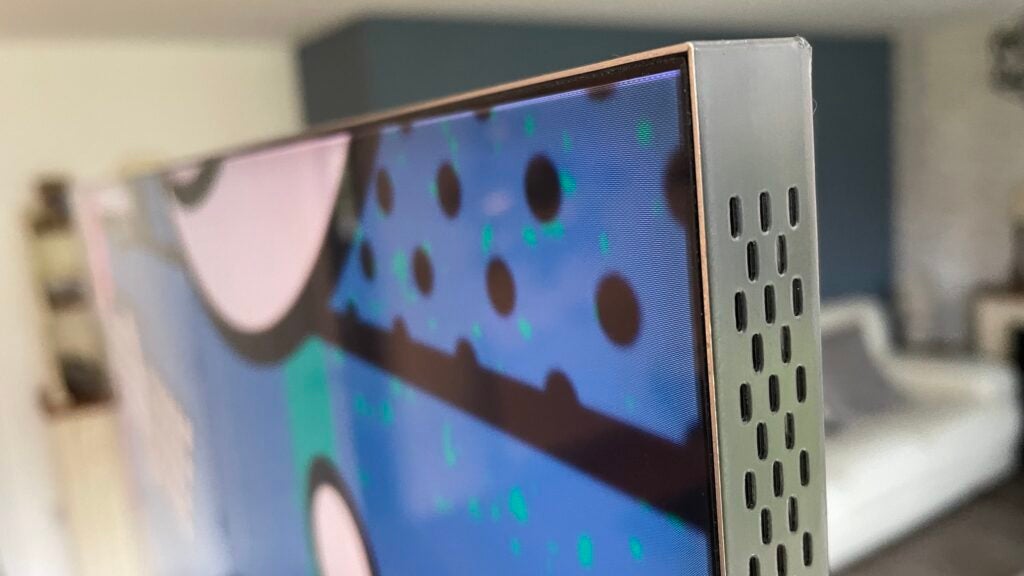
The trim side panels, meanwhile, enjoy a crisp silver metallic finish, given extra pizazz by perforations provided to help the TV’s side-mounted speakers deliver Samsung’s Object Tracking Sound system.
As usual with Samsung 8K TVs, the QE75QN900C’s connections are all carried on an external One Connect box that attaches to the screen – providing power as well as picture and sound – via a single cable, which is handy for keeping cable mess to a minimum. The One Connect box is designed so it can lean against the angled neck of the TV’s centrally mounted stand.
Two remote controls are boxed with the Samsung QE75QN900C. The standard one is a heavily buttoned one that’s still very easy to use, and a streamlined smart remote that Samsung clearly and rightly expects most will use. The star attraction of this smart remote is that it doesn’t need any batteries thanks to that fact it can recharge it via either a solar panel on its rear or, remarkably, your broadband router’s Wi-Fi signals.
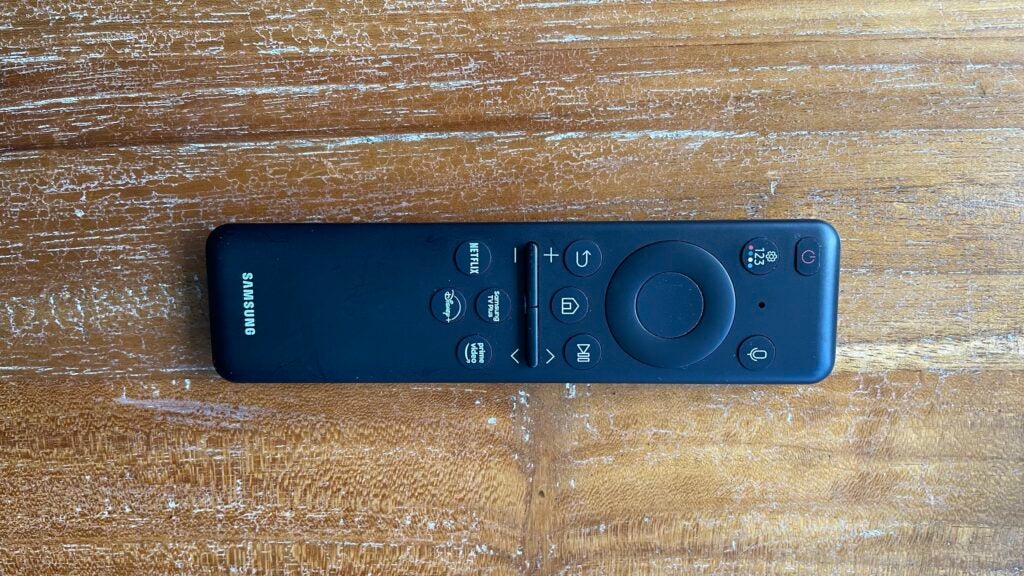
Features
- 8K resolution
- Mini LED lighting with local dimming
- Outstanding gaming support
The star attraction of the Samsung QE75QN900C is its huge 7840 x 4320 pixel count. That’s four times as many pixels as in a 4K TV, raising the prospect of a fantastically dense and detailed image.
Unfortunately, the content world stubbornly refuses to provide us with much native 8K content, so it won’t be often that you’ll get to experience the 75QN900C’s resolution in its native 8K glory. For the vast majority of the time you’ll be watching upscaled 4K or HD signals via the TV’s picture processor.
Just as well then, that the Neural Quantum 8K processor is comfortably Samsung’s most powerful yet. Particularly striking is Samsung’s claim it carries the combined learning of 54 separate neural networks, each of which beaver away to figure out how best to recognise and deal with different types of image content.
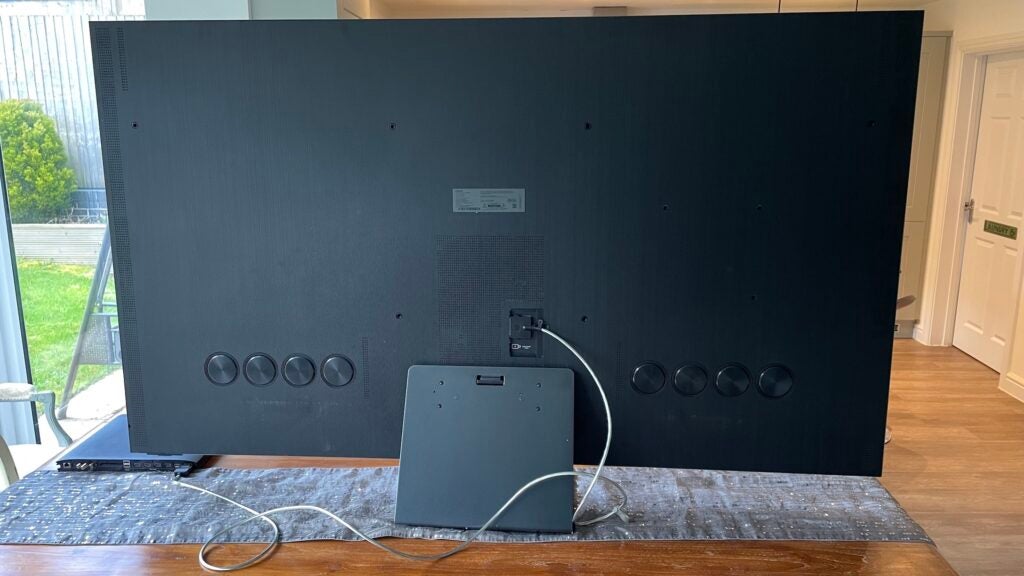
The 75QN900C is illuminated by a Mini LED lighting system that uses LEDs 40 times smaller than those in Samsung’s regular LED models, with a wide gamut of colours delivered using Quantum Dot technology. This is a combination Samsung calls Neo QLED.
The panel is a VA rather than IPS one, which would usually indicate superior black levels, while Mini LED can fit more LEDs into the same screen area, contributing to more control over light output.
The 75QN900C’s level of light control isn’t just down to Mini LEDs. It also drives those tiny LEDs using a local dimming system, where separate zones of the LEDs can output different amounts of light independent of their neighbours. The 75QN900C deploys 1920 dimming zones – a very high number even by the standards of the premium LCD TV world.
This is, though, the same number used in 2022’s Samsung QE75QN900B model; there hasn’t been a repeat of the substantial increase in dimming zones we’re seeing in the upper echelons of Samsung’s 4K Mini LED TV range in 2023. In fact, the 75QN900B uses the same number of dimming zones as the 75QN95C.
This matters because it takes away a key advantage – far more dimming zones – that Samsung’s flagship 8K TVs have previously enjoyed over its flagship 4K sets.
At which point it’s worth remembering the smaller pixel pitch you get with 8K screens can potentially deliver finer colour blends, a greater sense of depth, greater pixel density, and more finely resolved edges and curves. Obviously I’ll be looking at how well the Samsung QE75QN900C delivers on these sorts of potential ‘holistic’ 8K advantages.
Mini LED TVs traditionally depend on their brightness and immunity to screen burn as their raison d’être versus OLED TVs. With the latest QD-OLED and Micro Lens Array OLED TVs enjoying huge brightness increases, can the 75QN900C keep the Mini LED brightness ‘edge’ going?
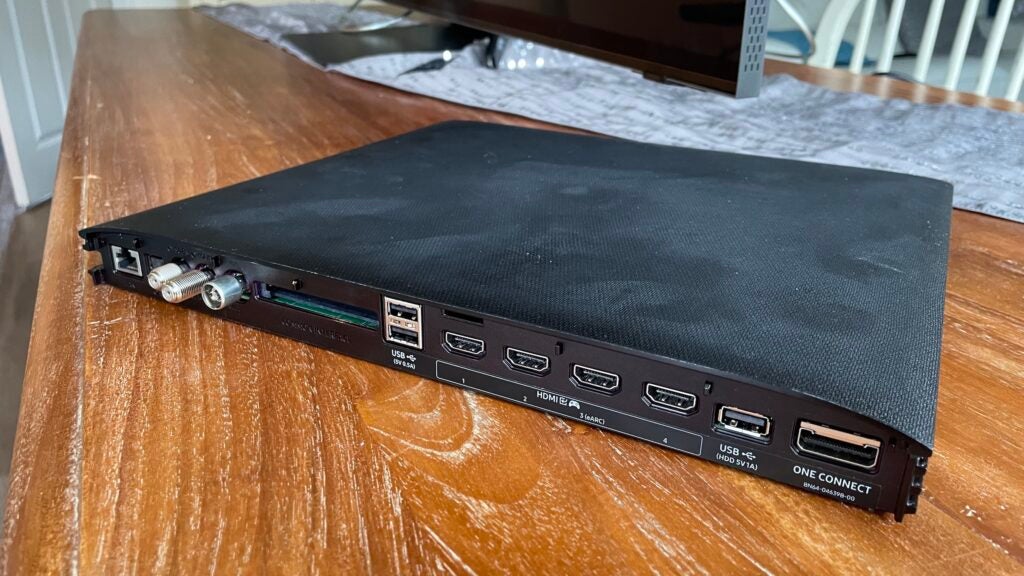
Yes, as it happens. Depending on the picture preset used, it delivers a measured peak brightness of between 2060 and 2,260 nits on a white HDR window that covers 10% of the screen. That’s around 50% higher than the measurements I’ve seen from even the best of the new OLEDs.
The 75QN900C’s brightness with a full screen white HDR image of 530 nits is more than twice as high as anything the best of even the new OLED TVs can manage. It’s equally important to stress that not even 1920 local dimming zones give you the sort of local light precision that OLED TVs’ self-emissive pixels can muster.
The Samsung QE75QN900C supports the HDR10, HLG and HDR10+ HDR formats, but not Dolby Vision. You can argue the more premium a TV, the less difference Dolby Vision delivers. The 75QN900C’s dynamic tone mapping system works at a 14-bit level, which will hopefully make it even better at optimising HDR10 content.
It would honestly be great, though, if Samsung joined its peers and brought Dolby Vision onboard. Especially as Dolby Vision is proving useful for delivering a more consistent HDR experience in the gaming world.
The 75QN900C is in every other way, though, exceptionally well set up for gamers. All four of its HDMI inputs can receive the 4K/120Hz signals the latest consoles and PCs are capable of. In fact, its frame rate support even stretches to 144Hz. The HDMI inputs also support variable refresh rates in the standard HDMI and AMD FreeSync Premium Pro versions, as well as auto low latency mode (ALLM) switching.
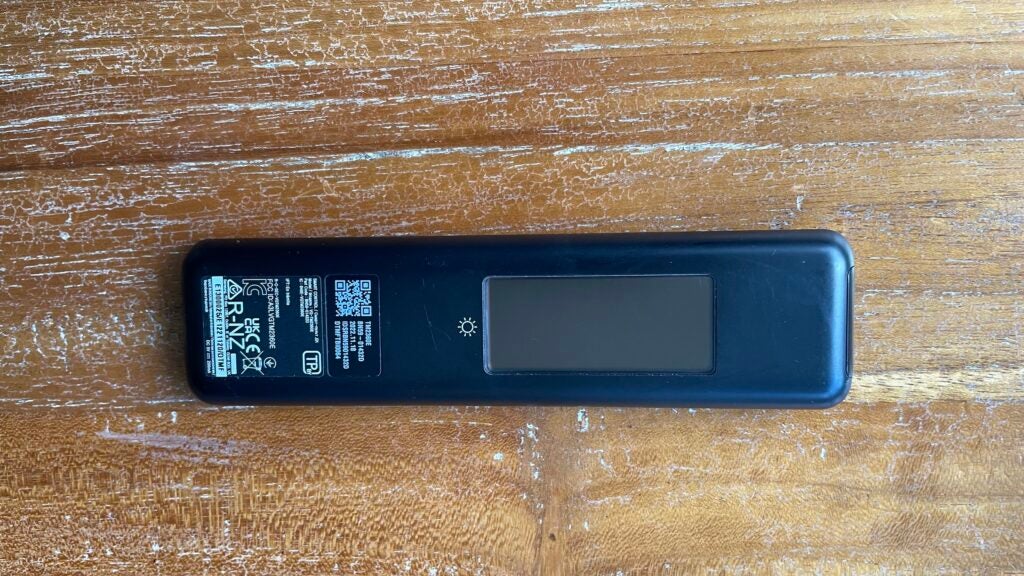
The Samsung QE75QN900C backs these connectivity features with an impressive number of gaming enhancements too, including support for ultra-wide aspect ratio PC gaming ratios, a virtual aiming point, a mini-map magnifier, an option to brighten the dark parts of the picture exclusively to help spot lurking enemies, and options for sacrificing a little screen response in return for small amounts of motion smoothing (potentially useful for exploration, rather than reaction-based games). All these options are available via a dedicated Game Hub menu screen.
And finally, the lowest input lag the screen is capable of with 1080p/60Hz games is 10.5ms. This is 1ms or so more than you get with Samsung’s 4K TVs, but it’s hard to imagine even pro gamers noticing the difference – and it’s actually a remarkably speedy result given how many pixels the TV is having to create on the fly when not playing native 8K games.
The 75QN900C’s smart features are provided by Samsung’s Tizen system – which has a mixture of pros and cons. The chief pros are its excellent support for voice recognition and control, and its huge array of content; apart from not carrying Freeview Play, pretty much every streaming service is present and correct. There’s an excellent content page dedicated to gaming sources, too.
The main cons are that the interface’s organisation feels long-winded and illogical at times, and that too much screen space is devoted to what is, essentially, advertising or pushed content.
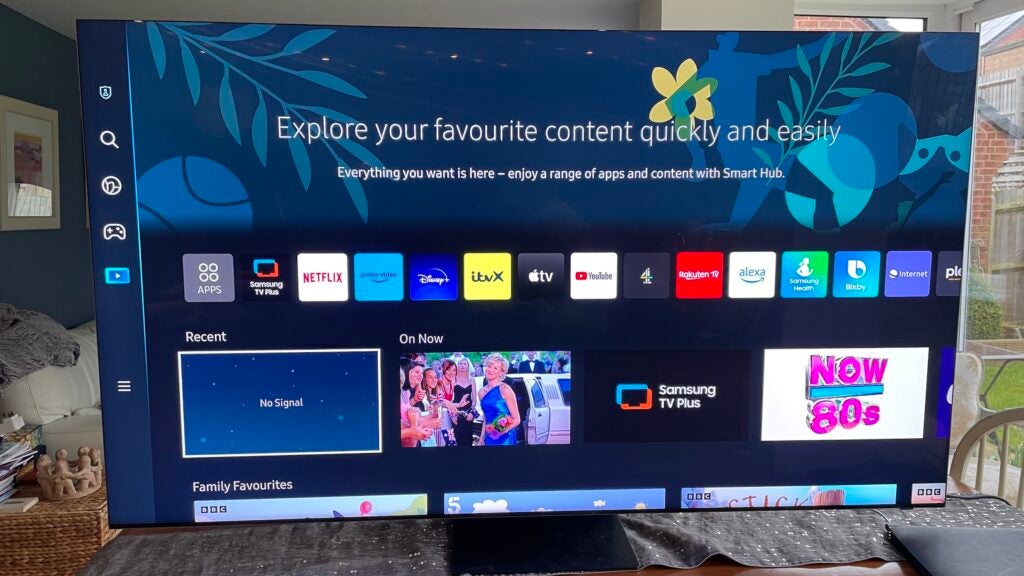
Turning to the 75QN900C’s audio, the speaker setup comprises a 6.2.4 channel count fed by an eye-catching 90W of power, with the drivers including a very noticeable array of eight large mid-range drivers ranged across the TV’s rear, and other speakers built into the TV’s edges. This is a substantial step up from the 70W, 4.2.2-channel set up of the QN95C 4K TV.
The speakers around the edge contribute to a ‘Pro’ version of Samsung’s Object Tracking Sound (OTS) system, which seeks to reproduce sound effects in the right place on the screen. So if a car drives across the picture, you hear its sound cross the picture too.
The 75QN900C’s hefty speaker count for a TV doesn’t stop it from also supporting Samsung’s third gen Q-Symphony system, where the TV’s speakers join forces with recent Samsung soundbars.
One last key point to mention with the Samsung QE75QN900C is its power consumption. There was a lot of excitement in the AV world back when it emerged that 8K TVs including the QN900C range were struggling to meet the EU’s newly introduced TV power consumption regulations.
In the end, though, this has turned out to be something of a storm in a teacup. For starters, the regulations only cover the TV’s out of the box settings with standard dynamic range content. So if you watch an SDR source without changing anything, it will be shown in a new Eco preset that does greatly limit the image’s brightness.
The brightness limitation doesn’t impact HDR playback, though, and it only takes a couple of seconds to switch away from the Eco mode if you find the default SDR images too dull. Samsung even gives you the option to switch away from the default SDR mode during its initial installation routine. So while the impact of the EU’s regulations is something you should be aware of, they’re not invasive enough to count as a ‘TV breaker’.
Picture Quality
- Extremely bright and colour-rich pictures
- Exceptional processing and upscaling
- Excellent but not flawless backlight controls
Given there’s no 8K content case for picking up an 8K TV, for most AV fans choosing between Samsung’s QN95C 4K TV and QN900C 8K TV will come down to a straight consideration of whether the QN900C performs significantly better. So it makes sense to look at the QE75QN900C’s picture quality in relation to that of the QN95C I tested recently.
It doesn’t take long looking at these two premium Mini LED models to see there are clear differences – so much so that it feels to me as if the sets are using different source panels. And fortunately given how much it costs, most of the differences go in the 75QN900C’s favour.
The most obvious one is that for most of the time, the Samsung QE75QN900C looks significantly brighter. Especially with full-screen bright and mid-bright HDR content. Things can get a bit more complicated during predominantly dark scenes, at least when using the Standard preset I suspect many will typically enjoy watching the most. But I’ll come back to this later.
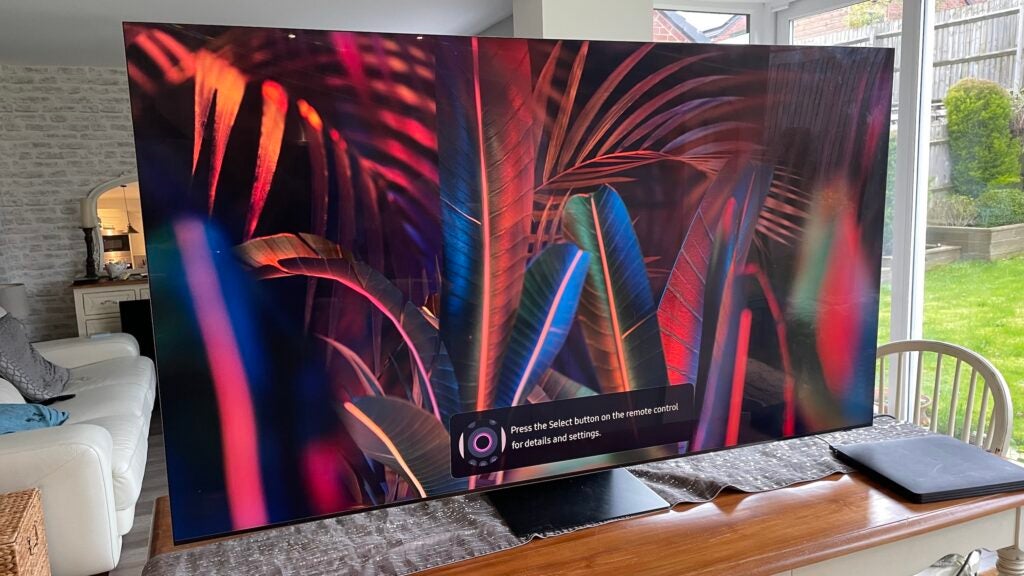
The 75QN900C’s brightness is a bigger deal than ever in 2023, now that Mini LED technology’s key rivals, OLED and QD-OLED, have found so much extra brightness. I wouldn’t say the 75QN900C is brighter than last year’s Samsung 8K TVs, but crucially it delivers significantly more brightness with full-screen and mixed brightness content, than even the latest premium OLEDs. In doing so, it maintains Mini LED’s main raison d’être (along with its freedom from screen burn concerns).
As well as looking brighter across the TV’s various presets with HDR content, the QE75QN900C delivers significantly richer, more vibrant colours. It’s this, more than anything else, that suggests the 8K TV’s panel comes from a quite different source to the QN95C’s.
The QN900C presents to me a much bolder sense of the advantages of using Quantum Dots for colour, making the QN95C’s colours look a touch flat and jaundiced by comparison. This is especially true when using the two TVs’ Dynamic and Standard presets, but even the QN900C’s accuracy-based Filmmaker mode preset enjoys a slightly warmer, more realistic default colour palette than the QN95C provides.
I should stress that this doesn’t mean the QN95C isn’t an outstanding TV. It is arguably the best 4K LCD TV ever, in fact. It’s just the QN900C’s extra brightness and colour saturation make it even better. Provided you’re careful with its settings…
The Samsung QE75QN900C controls its Mini LED backlighting slightly more effectively for most of the time than the QN95C does. For instance, dark scenes, especially in Standard mode, enjoy deeper, richer, more natural black levels on the QN900C – something that also means you’re less likely to feel aware (though they do still happen with very extreme content) of the slightly delayed and noticeable brightness shifts this year’s Samsung Mini LED TVs generate when there are sharp cuts between dark and bright HDR shots using the Standard preset.
The QN900C also manages to retain a little more brightness with very small light highlights of mostly dark pictures than the QN95C without generating the sort of backlight blooming/haloing that less able LED TVs with local dimming would exhibit.
On top of all this, the 75QN900C looks sharper and more detailed than the QE65QN95C. Samsung’s latest processor delivers even better upscaling of the sub-8K content than the already remarkable efforts of Samsung’s previous 8K generations. Pictures enjoy more density, smoother diagonal and curved edging, and perhaps most noticeable of all, more three dimensionality. And to be clear, these benefits, especially the three dimensionality, are noticeable from normal viewing distances. You don’t have to have your face right up against the screen.
If you do find some native 8K content (I have a show reel of 8K footage from Spears & Munsil), you will enjoy all the depth and sharpness mentioned with less noise and more purity. True, gorgeous ‘looking through a window’ stuff.
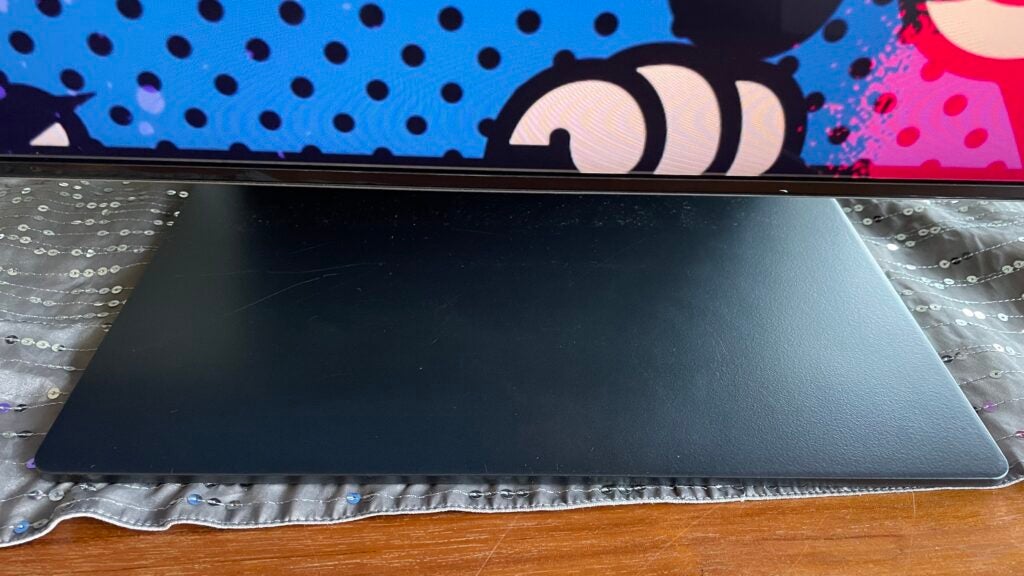
The Samsung QE75QN900C joins the QN95C in achieving remarkably deep black levels for an LED TV. It’s a struggle to spot much difference between the 75QN900C’s deep black colours and that of a good OLED TV during fades to black or in the darkest picture corners.
The 75QN900C also joins its flagship 4K sibling in delivering remarkably wide realistic viewing angles compared with most LCD TVs, and in being a dazzling gaming screen capable of creating gaming worlds with a combination of brightness, vibrancy and incredible detail that few rivals can match.
While the 75QN900C delivers a spectacular combination of brightness, vibrancy but also refinement and finesse for most of the time, it’s not without flaws. I’ve mentioned the slight brightening and dimming that happens in the Standard preset, and the TV also dims down bright highlights of mostly very dark HDR shots quite strongly to avoid backlight haloing or blooming. This dimming isn’t as heavy in its impact as it is on the QN95C, but OLED TVs with their self-emissive pixels can maintain small bright highlights with much more intensity.
While the 75QN900C’s more vibrant colours in Standard mode are mostly a good thing, they can sometimes feel too aggressive, especially with skin tones and other tones that contain a relatively high amount of red. So you’ll need to tweak the TV settings around this – or go for the milder Movie or Filmmaker mode presets.
Perhaps the biggest problem is that while the QN900C maintains brightness more consistently than the QN95C, its backlight system can generate more backlight clouding and haloing with mid-dark content that contains bright highlights. Scenes such as the debauched party that begins Babylon on 4K Blu-ray feature a mix of bright artificial light sources and relatively dark, detailed backgrounds look generally greyer, less punchy and less consistently lit than they do on the QN95C.
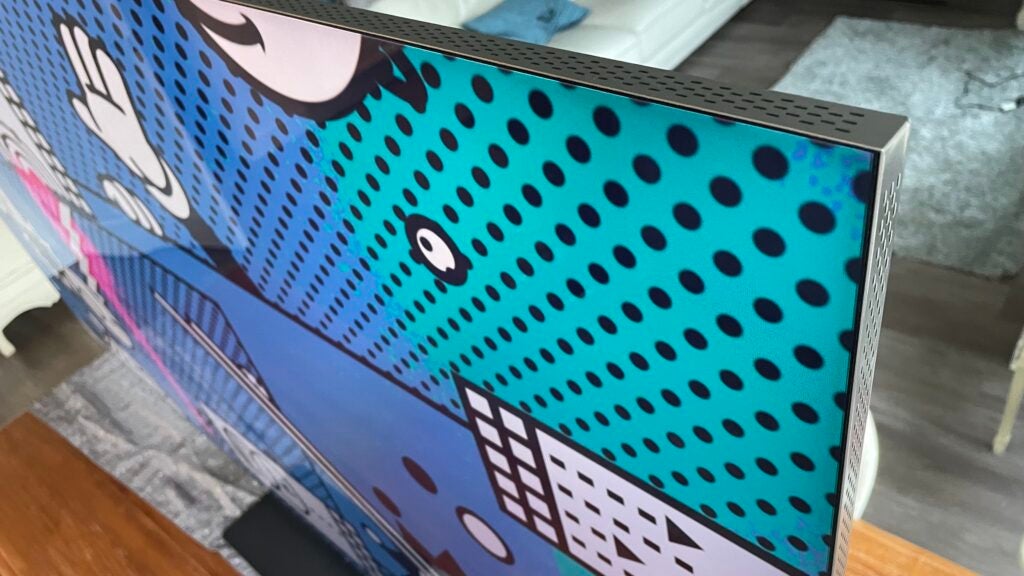
At the same time, dark scenes in Standard mode can suffer with a little crushing out of shadow details in the darkest corners compared with the QN95C – though again, this is not an issue in the TV’s more accurate presets.
Many of the 75QN900C’s niggles can be avoided simply by choosing a non-Standard preset, or making some small changes to the TV’s out of the box set up, even if achieving the best all-round results does mean compromising the TV’s key brightness and bold colour attractions.
It’s worth adding that the QE75QN900C supports the most comprehensive version of Samsung’s Smart Calibration system, which does a startlingly good job of creating an accurate picture using just your smart phone.
Sound Quality
- 90W of power
- 6.2.4 channels of sound
- OTS Pro processing
The QE75QN900C’s expansive array of speakers serve up a potent and impressively detailed soundstage. The star of the show is the effectiveness of the OTS Pro system that does an excellent job of making sound effects appear to come from the right place on the screen.
This is especially useful and effective with voices, but the accuracy with which all effects – including multiple object effects at once – are positioned on and even slightly off the screen helps to create a really involving audio experience.
The 90W of power at the QE75QN900C’s disposal proves enough to make sure those effects always sound clear, clean and well balanced, and while the speakers don’t project forward into a room much, the set does at least generate an effective wall of sound. The OTS system plays quite nicely with Dolby Atmos, too.
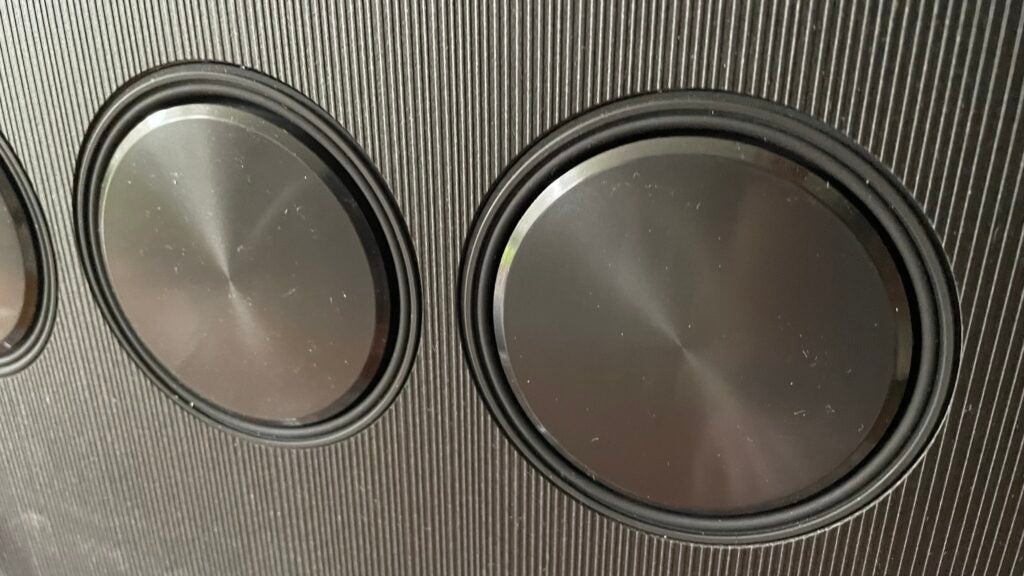
A bit more bass depth from the mid-range drivers would have been nice – though what bass there is tends to sound clean and is seldom troubled by distortions or drop outs. The sound stage isn’t quite powerful enough to meet the full demands of the densest, most powerful movie mix moments, tending to level off a bit early rather than expand all the way to a big crescendo.
Overall, the 75QN900C’s imperfections don’t stop it from being one of the better sounding TVs. And the speakers hold their own surprisingly well when partnered with a Samsung soundbar using Q Symphony.
Latest deals
Should you buy it?
You want bright, colourful ultra detailed picture quality: The QE75QN900C doesn’t just provide more resolution than its 4K siblings. Its colours are richer, and it’s consistently brighter too.
There’s no 8K content, and the TV doesn’t support Dolby Vision: The lack of 8K content is a pity, though the set’s upscaling of 4K and even good quality HD is pretty remarkable. There’s no Dolby Vision support, but the TV’s dynamic tone mapping system does extremely well without it!
Final Thoughts
With native 8K content remaining stubbornly absent from the AV scene and Samsung introducing significant improvements to its flagship 4K TV range, the pressure was on for the 8K QE75QN900C to justify its price premium over the outstanding QN95C.
It pulls it off thanks to a surprising combination of richer colours, more brightness, peerless LCD black levels, better sound and the sort of dense, three-dimensional pictures only 8K can deliver on a screen this big.
In short, while the QN95C range will probably still mark the upper limit of what most even high-end TV buyers can afford in Samsung’s 2023 range, you can’t accuse the QN900C of not giving AV fans with enough money to spare an excuse to go the extra resolution mile.
How we test
We test every television we review thoroughly over an extended period of time. We use industry standard tests to compare features properly. We’ll always tell you what we find. We never, ever, accept money to review a product.
Find out more about how we test in our ethics policy.
FAQs
A system of using much smaller LEDs than usual that allows TVs to provide more light control.
There are some YouTube videos and the occasional series available in limited territories.
A system developed by Samsung that uses a combination of speakers fitted around the TV frame and processing to make sound effects seem to be coming from the correct part of the screen.
UK RRP
USA RRP
EU RRP
CA RRP
AUD RRP
Manufacturer
Quiet Mark Accredited
Screen Size
Size (Dimensions)
Size (Dimensions without stand)
Weight
Operating System
Release Date
Model Number
Model Variants
Resolution
HDR
Types of HDR
Refresh Rate TVs
Ports
HDMI (2.1)
Audio (Power output)
Connectivity
Display Technology
Sustainability
Trusted Reviews’ holds the fact that global warming is not a myth as a core value and will continuously endeavour to help protect our planet from harm in its business practices.
As part of this mission, whenever we review a product we send the company a series of questions to help us gauge and make transparent the impact the device has on the environment.
We currently haven’t received answers to the questions on this product, but will update this page the moment we do. You can see a detailed breakdown of the questions we ask and why in our sustainability info page
Jargon buster
Neo QLED
Samsung’s branding for its TVs that feature a Mini LED backlight with their Quantum Dot colour technology
8K TV
8K refers to the resolution of a TV’s display, which equates to the number of horizontal and vertical pixels it can display. With 8K, there’s a total resolution of 7680 pixels horizontally and 4320 pixels vertically – four times that of 4K (3840 x 2160) and 16 times that of Full HD (1920 x 1080). That’s a jump from the 8.3 million of pixels in 4K to around 33 million pixels.
OTS
OTS stands for Object Tracking Sound and is an audio technology created by Samsung available in their premium QLED TVs. It’s made up of speakers (both physical, and in some cases virtual) in the top, sides and bottom of a TV that can more accurately track objects on the display.

























